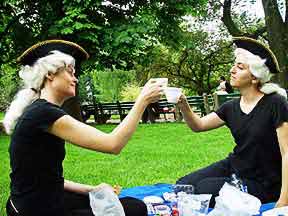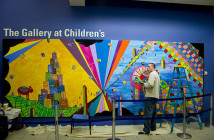I first met Fereshteh Toosi and Carolyn Lambert after a presentation they gave at the The Berwick Research Institute in late June. During this presentation, they handed out a numerically based questionnaire, asking all attendees to rate the experiences they had with the transportation they used getting to the Berwick that evening. Upon completion of the questionnaire, each participant was given a gift (perhaps as an incentive) of the automotive variety; I received an air freshener. The end result of this survey of sorts was a figure calculated by a formula provided on the questionnaire. After talking with some of the other survey takers, I became suspicious, as there seemed to be no correlation between that figure and our methods of travel. However, Fereshteh, with calculator in hand and scratch paper, quickly filled a page with complex enumerations, computing some end result from the combination of each individual’s statistics.
We next sat down for another presentation aided by Microsoft products. But before they began, we had received the result of their questionnaire. It was the number - 7,105,537. As it turns out, it had arithmetically nothing to do with the numerical figures each participant achieved. However, when turned upside down, the number, 7105537, spells ‘less oil.’ It seemed safe to say that the whole event was staged at this point; I know it’s a cliché, but I felt a bit like a Florida voter in November 2000. We had devoted ourselves to this investigation as it seemed as though it were perfectly legitimate. Our mere faith in science and numbers was the pretense by which Fereshteh and Carolyn made their work successful. They had not only duped us, they also apparently incriminated us in our use of fossil fuels.
The same was the case for the Fourth River Project they carried out in Pittsburgh, which went on to receive television news coverage. The ‘Project,’ or performance, was an exploration of the local mythology and its ability to inform the public. In fact, the diegesis of the performance rested on the strength of the mythology that they chose to participate within. Posing as researchers, they set out with a camera and various pieces of scientific costume (instrumentation, suitable attire) and began interviewing a variety of interpellators of this mythology. Like most stories passed along by word of mouth, there was much conflict, but eventually they landed themselves on a local news program, which ran a story on their study of the Fourth River. Their creation of an air of authority and a rhetorically smooth narrative in the performance had convinced the city of Pittsburgh (or at least those that subscribe to the drossy coverage of television news) that they were geological researchers studying an underground waterway, which I saw absolutely no empirical evidence for in the work’s documentation or the television news coverage. Nice work. (I won’t make any trite political jokes here.)
I suppose, with legitimacy a popular subject of one’s work, it might be something one is more keenly aware of. Early in a conversation I had with Fereshteh and Carolyn in preparation for this article, I was asked who my favorite artist was and other questions in lieu of my opinions on quality. I tried to get away with, “My friends’ work is my favorite,” but, of course, they wanted a real answer. I think what I eventually gave them sufficed, and I was declared ‘legit’ in their skeptical view (I’m going to look into Big, Red and Shiny credentials of some sort for future meetings such as this.) I suppose I may have earned their trust as they somehow felt it appropriate to ask me what my sexuality is after our discussion. Fortunately, my answer received no scrutiny.
When I sat down with them that beautiful Saturday morning, they immediately offered me some tea. I thought nothing of it, thinking it a relatively formal gesture of hospitality, but I now think they were up to something. You see, much of the work they have completed during their time at the Berwick entails tea. They’ve even begun changing various words to incorporate the word “tea” for the different platforms of their newly formed political party, the “Tea Party,” which distinguishes itself from the other parties by its “sense of style” and “unique” Tea-focused programs: “Securitea,” “Mobilitea,” “Communitea,” and “Partea." This work was in response to the security issues that have been raised about Boston’s public transportation playing on the ‘T’/tea homonym and Boston’s long history as a relatively progressive city. Perhaps we are just wary or feeling guilty of our place in the history of security failures in recent US history, but the newly proposed random searches of T riders is not an acceptable form of safeguarding for most users of public transportation. For “Securitea,” Fereshteh and Carolyn don themselves with white wigs and three-cornered hats, pass out tea bags, and sloganeer with catchy phrases like “Keep the ‘T’ out of our bags.” They repackaged each tea-bag with their own Securitea branding and covered the packaging with advice on how the tea might best be enjoyed along with its ingredients: “the finest fear and intimidation.” The Securitea, when taken as directed, becomes both a panacea and exacerbation for “any unwanted symptoms resulting from the ‘war on terror,’” just as allowing the T to search your bag may become.
This is the first time two artists have collaborated as Artists In Research at the Berwick, and though Fereshteh and Carolyn’s individual history as artists is extensive and rich, their work as a duo is quite fresh. Their individual work is strong, multi-layered, seeming to be the product of a long and arduous personal process. Fereshteh’s work often playing on representations of East and West while Carolyn’s work sculpturally represents a visceral impulse that we may all know but have never described in words. Their collaborative work is weaker by those standards, it is not as provocative and thoughtful. Perhaps, as often happens in collaborations, there is a compromise to achieve the goal of a final product, and whatever is removed from the work in that compromise removes the author from the work. That being said, however, it may be impossible to create works of the nature Fereshteh and Carolyn are without compromise. The work is often political and always more direct. It seeks to engage members of the public in a protest (Securitea), or just for the sake of engaging them (Fourth River).
They consider the public to be the audience of their performances, but only in a sense that they are attempting to communicate with the public. The communication is essential to their work, but they do not consciously attempt to position the audience in relation to their work, as is often the case with performance. They describe the audience, the public, as incidental as it is a naturally occurring entity within the world in which they participate or perform. In addition, their preparation for performances is minimal as they expect to learn from the audience/public that they are performing/participating with and the performance itself becomes within and about the audience interaction. The audience’s ideologies and mythologies govern the interactions in which they engage one another and Fereshteh and Carolyn become active participants along with the public in the performance. In a sense, they harness the interpellation which takes place between the public and the ideologies that give it its identity. Dressing in a three-cornered hat and passing out “Securitea” may seem a stretch for which to take hold of a Bostonian’s sense of self, but taking a caricature of the city itself and using it to show us another side the terror narrative is easy to understand and effective.
The Berwick encourages the Artists In Research to host public events and as their work is continually public, Fereshteh and Carolyn have this taken care of. However, they planned to “lead workshops encouraging citizens to imagine utopian designs for fantastic environmentally-safe vehicles,” but this idea was scrapped, perhaps in the face of the heavy-handed measures taken by the 'T' which begged for attention. A transportation project would actually have some significance here at this time in Boston, and particularly Dudley Square, the site of the Berwick. The MBTA has purchased “nearly 600 environmentally-friendly buses,” unfortunately they cannot be defined as “environmentally-safe” but perhaps, in places like Dudley Square, a commercial and residential neighborhood and the birthplace of Malcolm X, respiratory disorders (most notably asthma) will be reduced by 44 to 92% as “particulate matter emissions [will be reduced]by 92% and pollutants that cause smog by over 44%” by these new “friendly buses.” Its also important to note that “[w]here feasible, [the MBTA]is working to relocate maintenance facilities from urban neighborhoods [i.e. Roxbury] to industrial locations.” It’s too bad Boston’s local government wasn’t progressive enough to think to do this when they built the Dudley Square bus station. Diesel fuel is nasty stuff, it’s closest relative in the petroleum products family is heating oil. Its mass to energy output is higher than that of gasoline, but what doesn’t get burned of this heavy, oily fuel is released into the atmosphere. My lungs shudder at the thought, and I then suddenly have a coughing fit.
Fereshteh, Carolyn, where are you on this?!
Links:
Tea Party
The Berwick Research Institute
All images are courtesy of the artists and the Berwick Research Institute.
Christian Holland is a regular contributor to Big, Red & Shiny.



